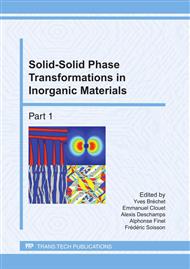p.985
p.990
p.996
p.1002
p.1008
p.1016
p.1022
p.1028
p.1038
Surface Segregation Maps Derived from Tight-Binding Ising Model
Abstract:
Surface segregation in transition metals can be analysed within a generalised Ising model,derived from Tight-Binding electronic structure calculations, which identifies three driving forces:the difference in surface energy and atomic volume between the two components and their tendencyto order or phase separate in the bulk. Using this ”three effects” rule, we present here general mapswhich predict the tendency of the solute metal element to segregate (or not) at the surface of a metalmatrix, for the 702 solute/matrix systems that can be formed with transition metal elements. Ourpredictions compare fairly well to the existing ab initio calculations and experimental data availableon these systems. The few exceptions, which mainly concern given matrix elements are discussed indetails.
Info:
Periodical:
Pages:
1008-1015
Citation:
Online since:
June 2011
Authors:
Keywords:
Price:
Сopyright:
© 2011 Trans Tech Publications Ltd. All Rights Reserved
Share:
Citation:


